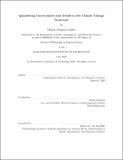Quantifying uncertainties and trends in the climate change trajectory
Author(s)
Lickley, Megan Jeramaz.
Download1191838907-MIT.pdf (51.49Mb)
Other Contributors
Massachusetts Institute of Technology. Department of Earth, Atmospheric, and Planetary Sciences.
Advisor
Susan Solomon.
Terms of use
Metadata
Show full item recordAbstract
The characterization of climate change depends on the location and rate of change while its impacts on nature and society also depend on vulnerabilities. This thesis contributes to the quantification of uncertainties, drivers, the spatial variability, and impacts of the climate change trajectory. Results of this work have evolved using a range of data science techniques that combine observations and Earth models aimed at informing adaptation and mitigation policies. In the first chapter, the drivers, timing, and impacts of aridity change over the 21st century are assessed using an ensemble of general circulation models (GCMs) together with population statistics. Results indicate that drier regions are projected to dry earlier, more severely and to a greater extent than humid regions, a result driven by differential changes in precipitation across aridity zones. Impacts are exacerbated as arid regions (such as the Mediterranean etc.) are more populated and experiencing much higher population growth than humid regions (which includes the Arctic). Under an unconstrained emissions scenario, GCMs project that most of humanity will live in a more arid climate by the end of the 21st century. For the second chapter, the southern African rainfall (SAR) response to sea surface temperature (SST) anomalies in the Indian Ocean, Atlantic Ocean and Niño 3.4 region is examined. This is done using observations and three large ensembles of GCMs run over the 20th and 21st century. Some previous studies suggested that the Indian Ocean dominated changes in SAR. In this chapter, Niño 3.4 SSTs are found to be most strongly correlated with SAR, while correlations between SAR and the Indian Ocean are dominated by their respective responses to Niño 3.4. GCMs project that this relationship persists under a warming background state. In the third chapter, the end of rapid warming is examined by considering emissions trajectories where atmospheric greenhouse gas concentrations ([GHG]) are stabilized. Under such scenarios, the rate of global temperature increases eventually steady at a rate significantly lower than those of the 21st century. I present a framework for defining the beginning of this 'Time of Steady Change' (TSC) and, with the use of GCM ensembles, evaluate the spatial variability of TSC. Results indicate that TSC occurs latest in low latitudes and in the Arctic, despite these areas steadying at very different absolute warming rates. These broad patterns are robust across multiple GCM ensembles and alternative definitions of TSC. The fourth chapter contributes to the measurement and analysis of sea level change. As an ice sheet rapidly melts, it produces a unique geometry of sea level change driven by perturbations in the height of the sea and crustal surfaces. While satellite altimeters only measure changes in the sea surface height (SSH), local impacts from changes in sea level depend on both changes in SSH and changes in the solid surface. The literature commonly conflates the two estimates by directly comparing them. Here I quantify the error incurred by conflating changes in SSH with changes in sea level for various ice mass flux scenarios. Results indicate that using satellite altimetry records to estimate global ocean volume changes can lead to biases that can exceed 15% and that the level of bias will depend on the relative contributions to sea level changes from the Antarctic and Greenland Ice Sheets. The final chapter of this thesis provides a probabilistic quantification of chlorofluorocarbons (CFCs) that were banked in old equipment and continue to be released, contributing to global CFC emissions. A Bayesian probabilistic model is developed to quantify banks and emissions of CFC-11, 12, and 113, incorporating the broadest range of constraints to date. Implied bank sizes of CFC-11 and CFC-12 are larger than recent international scientific assessments suggest, and can account for much of current estimated CFC-11 and 12 emissions (with the exception of increased CFC-11 emissions after 2012). If current banks are left unrecovered, their future emissions could delay polar ozone hole recovery by about six years and contribute 9 billion metric tonnes of equivalent CO₂ emission. While observationally-derived CFC-113 emissions are subject to uncertainty, they are too large to explain from banks, raising questions about sources of this gas as well.
Description
Thesis: Ph. D. in Climate Science, Massachusetts Institute of Technology, Department of Earth, Atmospheric, and Planetary Sciences, May, 2020 Cataloged from the official PDF of thesis. Includes bibliographical references (pages 159-172).
Date issued
2020Department
Massachusetts Institute of Technology. Department of Earth, Atmospheric, and Planetary SciencesPublisher
Massachusetts Institute of Technology
Keywords
Earth, Atmospheric, and Planetary Sciences.